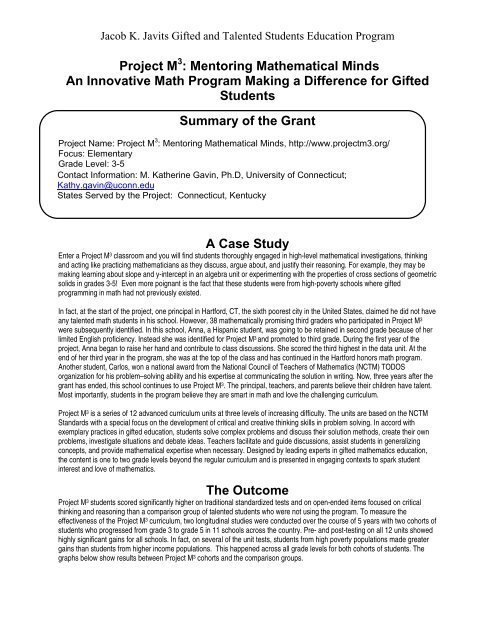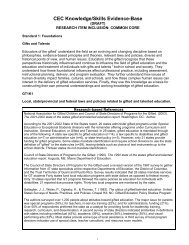Advanced Readers At Risk: Rescuing an Underserved ... - NAGC
Advanced Readers At Risk: Rescuing an Underserved ... - NAGC
Advanced Readers At Risk: Rescuing an Underserved ... - NAGC
Create successful ePaper yourself
Turn your PDF publications into a flip-book with our unique Google optimized e-Paper software.
Jacob K. Javits Gifted <strong>an</strong>d Talented Students Education Program<br />
Project M 3 : Mentoring Mathematical Minds<br />
An Innovative Math Program Making a Difference for Gifted<br />
Students<br />
Summary of the Gr<strong>an</strong>t<br />
Project Name: Project M 3 : Mentoring Mathematical Minds, http://www.projectm3.org/<br />
Focus: Elementary<br />
Grade Level: 3-5<br />
Contact Information: M. Katherine Gavin, Ph.D, University of Connecticut;<br />
Kathy.gavin@uconn.edu<br />
States Served by the Project: Connecticut, Kentucky<br />
A Case Study<br />
Enter a Project M 3 classroom <strong>an</strong>d you will find students thoroughly engaged in high-level mathematical investigations, thinking<br />
<strong>an</strong>d acting like practicing mathematici<strong>an</strong>s as they discuss, argue about, <strong>an</strong>d justify their reasoning. For example, they may be<br />
making learning about slope <strong>an</strong>d y-intercept in <strong>an</strong> algebra unit or experimenting with the properties of cross sections of geometric<br />
solids in grades 3-5! Even more poign<strong>an</strong>t is the fact that these students were from high-poverty schools where gifted<br />
programming in math had not previously existed.<br />
In fact, at the start of the project, one principal in Hartford, CT, the sixth poorest city in the United States, claimed he did not have<br />
<strong>an</strong>y talented math students in his school. However, 38 mathematically promising third graders who participated in Project M 3<br />
were subsequently identified. In this school, Anna, a Hisp<strong>an</strong>ic student, was going to be retained in second grade because of her<br />
limited English proficiency. Instead she was identified for Project M 3 <strong>an</strong>d promoted to third grade. During the first year of the<br />
project, Anna beg<strong>an</strong> to raise her h<strong>an</strong>d <strong>an</strong>d contribute to class discussions. She scored the third highest in the data unit. <strong>At</strong> the<br />
end of her third year in the program, she was at the top of the class <strong>an</strong>d has continued in the Hartford honors math program.<br />
Another student, Carlos, won a national award from the National Council of Teachers of Mathematics (NCTM) TODOS<br />
org<strong>an</strong>ization for his problem–solving ability <strong>an</strong>d his expertise at communicating the solution in writing. Now, three years after the<br />
gr<strong>an</strong>t has ended, this school continues to use Project M 3 . The principal, teachers, <strong>an</strong>d parents believe their children have talent.<br />
Most import<strong>an</strong>tly, students in the program believe they are smart in math <strong>an</strong>d love the challenging curriculum.<br />
Project M 3 is a series of 12 adv<strong>an</strong>ced curriculum units at three levels of increasing difficulty. The units are based on the NCTM<br />
St<strong>an</strong>dards with a special focus on the development of critical <strong>an</strong>d creative thinking skills in problem solving. In accord with<br />
exemplary practices in gifted education, students solve complex problems <strong>an</strong>d discuss their solution methods, create their own<br />
problems, investigate situations <strong>an</strong>d debate ideas. Teachers facilitate <strong>an</strong>d guide discussions, assist students in generalizing<br />
concepts, <strong>an</strong>d provide mathematical expertise when necessary. Designed by leading experts in gifted mathematics education,<br />
the content is one to two grade levels beyond the regular curriculum <strong>an</strong>d is presented in engaging contexts to spark student<br />
interest <strong>an</strong>d love of mathematics.<br />
The Outcome<br />
Project M 3 students scored signific<strong>an</strong>tly higher on traditional st<strong>an</strong>dardized tests <strong>an</strong>d on open-ended items focused on critical<br />
thinking <strong>an</strong>d reasoning th<strong>an</strong> a comparison group of talented students who were not using the program. To measure the<br />
effectiveness of the Project M 3 curriculum, two longitudinal studies were conducted over the course of 5 years with two cohorts of<br />
students who progressed from grade 3 to grade 5 in 11 schools across the country. Pre- <strong>an</strong>d post-testing on all 12 units showed<br />
highly signific<strong>an</strong>t gains for all schools. In fact, on several of the unit tests, students from high poverty populations made greater<br />
gains th<strong>an</strong> students from higher income populations. This happened across all grade levels for both cohorts of students. The<br />
graphs below show results between Project M 3 cohorts <strong>an</strong>d the comparison groups.

















